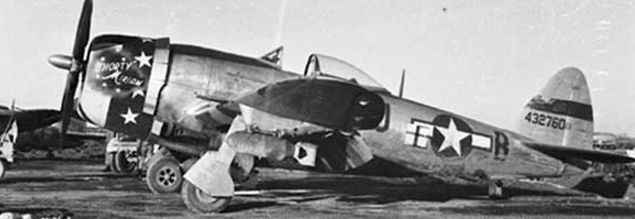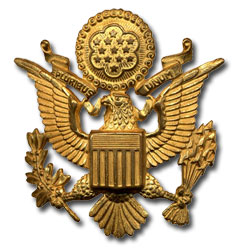The four friends were part of the 356th Fighter Squadron of the 354th Fighter Group and would join the group in Normandy on June 30. The 354th flew in the Ninth Air Force and was a tactical air force that flew armed reconnaissance missions for the most part, as opposed to the long distance bombing runs of the Eighth Air Force. On August 1,1944, the entire Ninth Air Force became part of the XIX Tactical Air Command and would closely support Patton's Third Army until the end of the war. This meant that Davis would be flying armed reconnaissance missions instead of bomber escorts, but it would be in an airplane he had never flown in. He trained in the Republic P-47 Thunderbolt in the United States and in England, but a surprise awaited him when he arrived in France. The 354th Fighter Group was the first to be armed with the new North American P-51 Mustang. When Davis arrived in France, he saw for the first time the airplane in which he would fly fifty missions.
The Mustang and the Thunderbolt were very different planes, but were both the best fighter-bombers in the American stable during the war. The P-47 and P-51 weighed 14,000 lbs. and 7,000Ibs. respectively, with the Thunderbolt carrying eight .50 caliber machine guns to the Mustangs six. The P-51 had a range of 1,300 miles and a bomb capacity of 1,000Ibs., but the P-47 only had a range of 637 miles and a bomb capacity of 1500 lbs. The key difference between the planes proved to be the range. The longer range allowed the P-51 to escort heavy bombers deep into Germany and defend them against the Luftwaffe, where the P-47 could not. Through his experiences, Davis thought the P-51 was more maneuverable than the P-47 and thus favored the Mustang.
He arrived on Omaha beach three weeks after the D-Day invasion. He then proceeded to A-2, the first American fighter airfield in France at Criqueville-en-Basin, on the second of July. This would be the first of four airfields he would fly from in France. When he arrived at A-2, Davis never got to practice in the new P-51; he would have to go on his first mission never having flown in the Mustang. "I was so intent on staying on my element leader's wing that he shot down a ME-109 on my first mission and I didn't even know it." At this point, Lt. Davis didn't have his own aircraft, so he would fly Capt. Jim O'Conner's on most of the early missions. He had a close call at this first airstrip when his engine starting running rough on the return flight. The engine eventually died and he had to "dead stick" the landing with no power, and when his crew removed the cover from the engine, light showed through it on both sides. The Packard-built Merlin V-1650-3 engine had thrown two pistons and ripped a hole clear through the block. This would not be the last close call for Davis, but it was one of the scarier moments for the young pilot. While at A-2, one of the three men that Lt. Davis became close to, Jim Harbers, was killed by ground fire while flying a mission. Lt. Harbers was one of the 107 total pilots killed in action for the 354th during the war.
Once Patton had pushed the Germans back enough, the men of the 354th moved to A-31 at Gael in Brittany, France from August 11-13, 1944. Davis would finally receive his own plane while at this airfield. The Mustang he would fly bore the letters AJ-B on the side. AJ was the squadron marking for the 356th and the third letter distinguished between planes of that squadron. While at A-31, which had originally been a German airfield, Lt. Davis saw a memorable performance by Spike Jones in one of the captured German hangers. Patton had liberated the airfield and then continued to drive towards Germany, so the group spent only a short month in Gael and then moved on to A-64 at Orconte, France to be closer to the Third Army. It would be at A-64 that the men of the 354th received the disheartening news that they would no longer be flying their beloved P-51 Mustangs. The entire group switched to the P-47 Thunderbolt on November 13, 1944. The men were disappointed by this turn of events, but nevertheless pushed on toward Berlin.
The 356th loved their P-51s, but the men made the best out of their new aircraft. The P-47 had a larger engine cowling that allowed much more nose art than the Mustang. In the group, Davis's squadron had the most unique design. The engine cowling had a blue stripe with white stars inside it, while the other squadrons only had a solid color on the nose.
In addition to the squadron colors and designs, many men added their own markings to the planes. When Lt. Davis received his P-47D, serial number 44-32760, he had an artist named Will Louie paint a design with the name Shorty Miriam on it. Of all the possible designs or phrases Davis could have put on his plane, he chose one to honor his wife. In spirit and name, Miriam Davis flew with her husband over Europe.

Lt. Norman Davis personal bubble canopy P-47D Thunderbolt loaded with a 500lbs bomb under each wing at A-98, France. Squadron artist, Sgt. William W. Louie painted the "Shorty" Miriam nose art.
When Norm departed in 1944, Miriam didn't waste much time helping out back home. Miriam volunteered with the Red Cross starting in June of 1944, tap dancing at Fort Benjamin Harrison and Camp Atterbury in Indiana. She witnessed first hand the terror of war when the 106th Infantry, which included many local boys, went overseas in late 1944. They were routed during the Battle of the Bulge and many women Miriam worked with lost boyfriends, fiancées, or husbands. It was the darkest time of the war for her. She woke every day not knowing whether Norm would share the same fate as one of those men. He, however, woke every day with the determination to ensure an Allied victory and his return to the country and woman he loved.
As she worked hard at home, Davis was flying from A-64, Orconte, until it became flooded at the end of November. He was forced to move back to England for a short time and flew escort missions with the Eighth Air Force's B-17 bombers. It was during this time that Lt. Davis got his lone kill of the war. He was flying over Belgium and shot down a German ME-109. "There were very few times we encountered German aircraft in the air while I was in the war, the Luftwaffe was not as much of a presence compared to early on in the war." He escorted heavy bombers for a very short time and returned to the armed reconnaissance of the Ninth Air Force in the middle of December. The 354th Fighter Group had moved to A-98 at Rosieres-en-Haye on December 1, and that was where Davis rejoined them. He would fly the remainder of his missions from this strip, including the January fifth mission that earned him the Distinguished Flying Cross.
He was the flight leader on an "armed reconnaissance mission…and located an ammunition train of 50 goods cars. With fierce determination, Lt. Davis skillfully maneuvered his aircraft and led the attack...obtaining direct hits with his bombs...The entire train was destroyed." His last flight with the 354th was one from England back to A-98 with the new P-51s for the group. After four months of being the "Pioneer Mustang Group" flying P-47 Thunderbolts, the men of the 354th got their Mustangs back.
On February 15,1945, he would end his tour of duty. He sent a message to Miriam that simply read "COMING HOME" in huge type. He flew a total of seventy-four missions, fifty in a P-51 and twenty-four in a P-47, thus earning an Air Medal with two silver oak clusters for these missions. He returned to New York on the luxury liner New Amsterdam. The trip took only five days and lacked the convoy present on the trip over. He reunited with Miriam in Indianapolis. The couple then traveled to Miami for a week of well deserved "R & R". After the break, Davis would serve out his military service as an instructor at Perry Army Air Force Base in Florida. While instructing there, he took Miriam up in an AT-6 trainer. Training new pilots could be more frightening than combat for him sometimes, but he finished instructing without incident and his military career ended on August 12,1945. Nearly three years after leaving Indianapolis, he returned with Miriam to start the family that was put on hold for the war.
Norm Davis's story is one that is common of his generation. He was called on to fight in World War II like hundreds of thousands other American men, and he did as much as any American to end it as quickly as possible with an Allied victory. He had been forced to leave behind many loved ones, but one girl was harder to leave behind than the rest. She was the one that the American soldier wrote to every chance he had. She was the one that men thought of when they were scared, alone, and trying to stay sane. She played an intricate role in the soldier's life before, during, and in many times, after the war. Many of these relationships hold strong to this day. Miriam and Norm Davis celebrated their sixtieth anniversary on October 23, 2002. Their relationship has lasted over sixty years, and more importantly it helped Norm to survive World War II. Their dedication to each other was one of strongest factors to guide him through the war. Without Miriam's support and strength, his morale and will to push forward would not have been as strong. World War II was fought and won with the blood, sweat, and sacrifice of American boys, but they were counting on the strength and support of the women they had to leave behind to get them through the terror and struggle of war.





